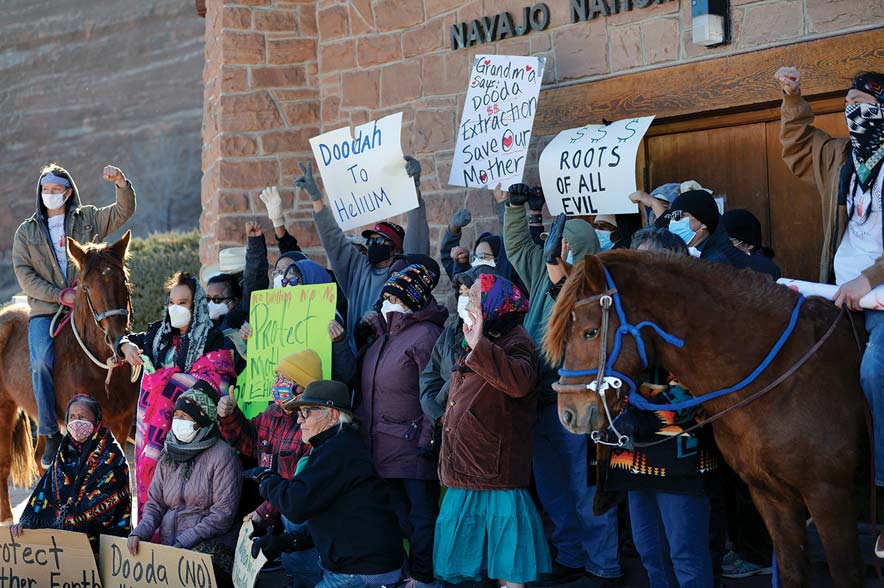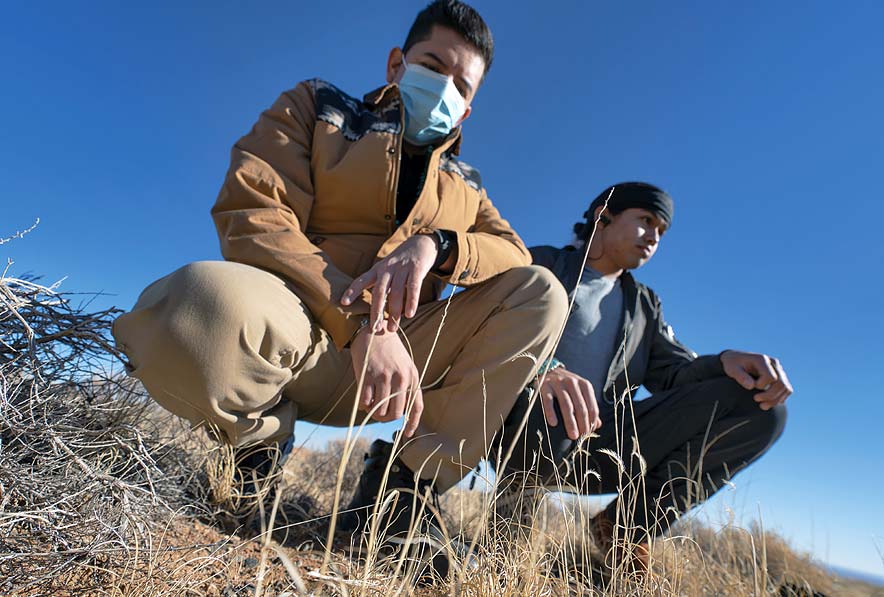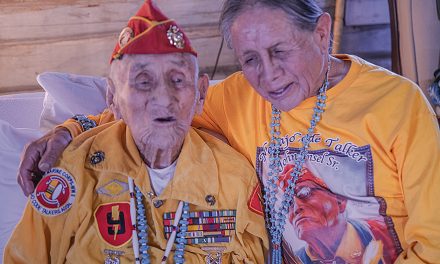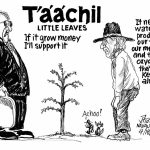
Ceremonies – ‘our only hope’: Feud erupts over helium mining in Tsé ‘Ałnáozt’i’í

Donovan Quintero | Navajo Times
Protestors against helium proposals pose in front of the Navajo Nation Council Chamber on Jan. 27, 2022, in Window Rock.
WINDOW ROCK
Michael Goldson stands atop a hill he grew up playing on.
Dibé Ntsaa is still blanketed with snow to the northwest, and Tsé Bit’a’í and its wings can be seen to the north.
The sky is blue but there is a slight breeze blowing from the west across the seemingly untouched brown landscape he calls home, nestled under Dziłk’i Hózhónii in Tsé ‘Ałnáozt’i’í, New Mexico.
Goldson, 32, is a Hataałii, a Diné practitioner.
He walks along the ridge and talks about the many herbs he collects for ceremonies he conducts for families throughout the area, including Farmington.
“I use Navajo ceremonial herbs from this whole region in the proposed Dome Area 1,” Goldson said.
There is no actual dome in the landscape. Goldson refers to the proposed helium mining site the Navajo Nation Oil and Gas Co. calls “Porcupine Dome QA.”
Porcupine Dome is one of five areas that were marked off for a more than 13,275-acre helium mining site in the small community of Tsé ‘Ałnáozt’i’í.
Goldson and his family’s home-site lease sits in the middle of the proposed area.
The home site might look unassuming – even to a Navajo not from the area – because there are no trees. The home site comprises two hogans, one house, a shack, a bread oven, and a corral. A single-lane dirt road leads to the house.
Goldson said he conducts ceremonies for his patients in one of the hogans. With the herbs he sometimes collects from Dziłk’i Hózhónii, or Beautiful Mountain, he performs various types of Hóchxǫ́ʼíjí, Naayééjí, and Hózhǫ́ǫ́jí ceremonies, to name a few.
Goldson said if helium mining is approved in the area, it would destroy even more of the delicate environment that is barely in place.
He said he once conducted ceremonies on Dził Dahiigháł, or Harper Hill, located west of Farmington. But because of the mining developments that have started there, he no longer does that.
“When I am doing a ceremony, there’s drilling going on all around where I’m putting stones down,” Goldson said. “We have no privacy when we’re driving to the site.
“There are all these rig workers; they’re staring at us,” he said. “They act like they’re the ones that own that land. They look at you like you’re trespassing. It doesn’t make it exciting.
“Then when we finally get to set up, there’s all this noise, béésh dadiitsʼaʼ,” he added. “You hear those pumps. Áko, tsodizin nizhónóo ádoolnííłée dóó sin kweʼé nizhónóo bá nizhdoojih, yéeniʼ tʼóó dahodiitsʼaʼ, yaʼ? Áko doo yáʼáshxǫ́ǫ da.
“You don’t have that peace,” he said, “you don’t have that reverence, that sacred space. Tʼóó ałtsxo dahóółchxǫʼ around that area.”
Níłch’i Ászólí

Donovan Quintero | Navajo Times
Navajo traditional practitioner Michael Goldson, left, and his helper Joshua Notah, kneel by a plant in Tsé Ałnáozt’i’í’ on Jan. 27.
Goldson said the prospect of helium mining operations could create a similar environment in Sanostee.
And not only that, the constant vibration of the construction could start to destroy delicate sacred sites that are not listed in Speaker Seth Damon’s helium development legislation identifying several sacred areas.
Damon’s 557-page intricately written legislation details costs, potential profits, and acres each site would take in Sanostee and in Teec Nos Pos.
The proposed helium development sites in Sanostee are located on the north and south of the community.
A third site called “Tocito Dome,” which Navajo Transitional Energy Company purchased from Tacitus LLC, a helium development company, is located on the east.
In Teec Nos Pos, one area would be called “Tohachee Wash.”
The proposed helium development site would take up more than 11,000 acres of land made up of two separate mining sites: Porcupine Dome QA and Big Gap Dam QA, which was briefly labeled as Beautiful Mountain.
The name was changed during the Navajo Nation Council’s winter session through a chapter resolution after many community members thought Navajo Oil & Gas was trying to change the mountain’s name.
Oil & Gas CEO James McClure said the company worked with the tribe’s Department of Natural Resources and Department of Justice to develop three helium operating agreements that would occupy a combined total of 30,080 acres if they are approved.
McClure said his company expects to drill 83 wells at locations in the Sanostee area, including near Goldson’s family home site, which could make mining in the area contentious because of the planned construction needed to construct well sites.
Azeeʼígíí da’diitsʼaʼ
In a 45-page report from Navajo Oil & Gas included in the legislation, the company reported construction on at least 24 miles of new road, and piping and power lines would parallel the roads to the 83 anticipated well sites.
If all the sites are opened, 514 acres would be used. Additionally, up to 249 acres would no longer be available for grazing during production. The report suggests that not all sites would open.
The community’s groundwater would not be used to supply water, report says. Water used for construction would be “bought, pumped, and trucked by” Navajo Tribal Utility Authority.
And drill sites would be protected by “casing and cement.”
Vegetation could be indirectly impacted, burying plants and exposing plant roots during the construction phase. In addition, noxious weeds could also be introduced to the area brought by construction vehicles.
“What I was taught when I make herbs, these, díí azeeʼígíí da’diitsʼaʼ jiní, they can hear us,” Goldson said. “Áádóó éí biniiyé bichʼįʼ nááʼiinįįh, you offer it corn pollen first. Áádóó bichʼįʼ yájíłtxiʼ dóó bichʼįʼ tsozdilzin.”
Goldson stood on the side of a hill and pointed out that even the black lava rocks are used in a sweat lodge.
He said plants such as tł’ohnást’ąsi, ch’ildiilyésii, and tsédídééh used in Navajo ceremonies have become harder to collect because of climate change, mining operations and family land disputes.
“This is our only hope to do ceremonies now,” he said, “you can’t really do it out there. Kʼad kéyah baa saa hólǫ́, Bilagáana bichʼįʼo. Áko éí tʼéí ákótʼée.”
Resisting helium
Helen Henderson, one of the matriarchs of the area, said she doesn’t support helium mining on her family’s “pristine” land.
“Haʼátʼíísh éí biniiyé ahótʼáo éí bee nináádazhdiikai?” Henderson asked on Jan. 23 during a community meeting sponsored by Damon, who wanted to gather more information from the public. “’Dooda daniidzin, kǫ́ǫdí. Doo nihił yáʼádaatʼééh dah.”
Henderson, who spoke only in Navajo, said many homes located on the proposed mining sites would be impacted.
The matriarch added that the 1868 treaty should protect and defend the Navajo people like her son, a military veteran.
“T’áá ałtsxo bee nihichʼą́ą́h hólǫ́,” she said. “Éí bikʼeh dadidiidleeł. Bee nichʼįʼ ndookǫs, nihichʼįʼji’ azt’ą́ą dooleeł, dishníigo sodiszingo bee haasdzííʼ bindąą.
“Kǫ́ǫ́ yáʼátʼéehgo nihił náhwiidookʼąąh,” she said. “Áádóó ahótʼáo nihichʼįʼ naatʼiʼí dooleeł.”
Community members who support the helium development say it would provide much-needed money the chapter could use to improve homes for elders, improve roads, and put millions in scholarship money for the area’s youth.
Melvin Smith, who’s been using helium gas in his welding work for more than 30 years, said the money Navajo Oil & Gas gives to the community could help improve the area and pave the way for residents with no electricity or water to get the service.
“They “(Oil & Gas and Damon) said they want to help us,” Smith said on Jan. 23. “How come you don’t understand that? They said they want to give us money. Let’s make it happen.”
Smith challenged his neighbors to help their community because many people are against helium mining.
“For you who say ‘no,’ what’s your alternative plan to help your community? What do you plan to bring to help your community if you don’t want helium mining?” Smith asked.
“Where were you people at when plans to develop helium began?” he asked. “If this doesn’t happen, what do you plan to do to help our community? Let’s get behind our chapter, our elected chapter leaders that you voted for to represent our community.”
Navajo Oil & Gas stated it would commit to a 1% profit-share, or $1.7 million, that would be paid to the chapter. They also added a total of $200,000 would be paid into the scholarship fund.
The legislation was tabled last Thursday, during the winter session, after several delegates raised concerns about the drilling technique that could be used.
Delegates also asked for clarification on the profit-sharing agreement with Tsé Ałnáozt’i’í Chapter.
Elouise Brown, Dooda Helium organizer and a former grazing official, and supporters rallied outside the Council Chamber.
“To table means that it’s very possible it could just die, the legislation, that’s what we hope for,” Brown said. “If they don’t come up with their documents, I’m almost sure they won’t come up with the documents, that’ll be great. As long as they don’t have their documents by the spring session, it’s dead.
“But if they should, then we continue to oppose it,” she said. “I’m pretty excited, pretty happy because we have more time to prepare and more time to talk about what we’re going to do next.”
Why here?
Goldson and his helper, Joshua Notah, 23, scanned the wide-open valley for herbs. The scarce pickings don’t deter them from searching.
The young Hataałii once again looked out at the seemingly empty landscape.
“One day, you find out that a mining company is coming into your whole family’s area, and you’re going to lose possibly a week to a month,” Goldson said, as he looked at the hogan he’s performed many ceremonies in.
“Why did they put the project in some of the most pristine parts of this chapter,” he said, “where people want to live, where people want to build their homes?”








 Highway 264,
Highway 264, I-40, WB @ Winslow
I-40, WB @ Winslow